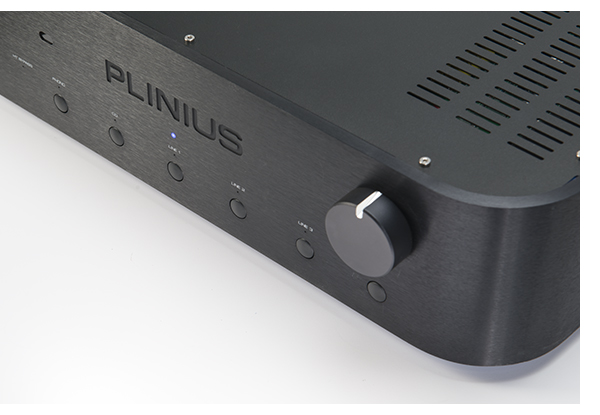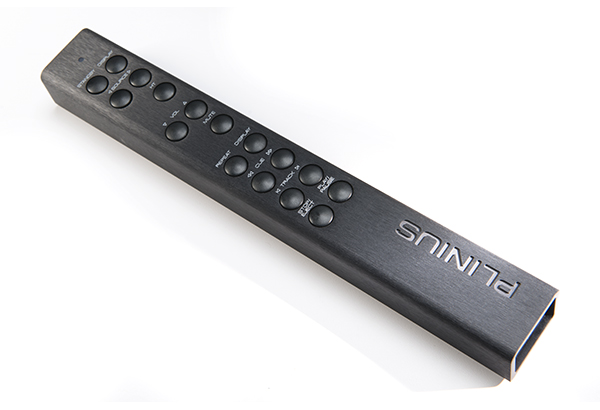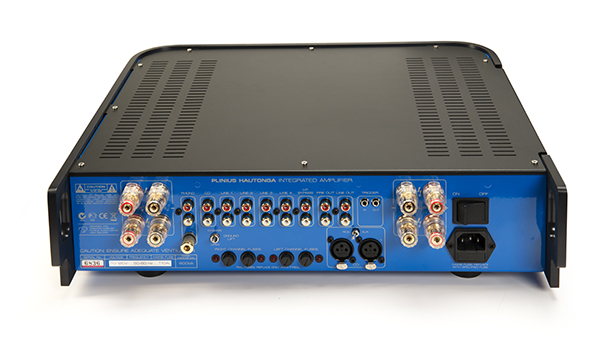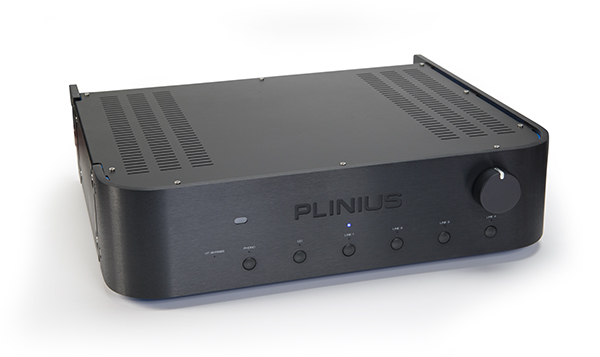Plinius Hautonga Indeed, a Breath of Fresh Air
By Jeff Dorgay In case Plinius is a company that has slipped under your radar, they hail from New Zealand, and have been making incredible products for years now.
In case Plinius is a company that has slipped under your radar, they hail from New Zealand, and have been making incredible products for years now.
However, those that do know about the brand are doggedly loyal. It’s a brand that I don’t think I’ve ever heard anyone slag out on the various internet forums, so they are doing something right.
Something indeed. Having built their reputation on big, class-A power amplifiers, the Hautonga you see here is an integrated amplifier (with phono stage, no less) that features a 200-watt per channel class AB power amplifier. Yet, much like the Burmester 911 mk. 3 and the new D’Agostino Momentum, the Plinius comes up with a remarkably grain free sound, that just might fool you that this understated beauty has a class-A amplifier under it’s cover. Yet the MSRP is only $5,750.
It’s a very understated box, with gently rounded corners and an asymmetrical top plate, yet the rear panel is bright blue, similar to the French racing blue you’ve seen on factory Renault race cars. It makes for a nice accent stripe where the top panel meets the casework. The Hautonga is beautifully machined and is available in black or silver. The control layout is the ultimate of simplicity; a large volume control and gently rounded push buttons to control the inputs. Oddly, a balance control is absent – no big whoop for digital music enthusiasts, but this might be somewhat inconvenient for analog lovers. Even if it were implemented from the remote – and the Hautonga has a sleek, stylish, yet commanding remote.
A complete integrated
In the tradition of the best integrateds, the Hautonga features an on board phono stage – handy for those wanting to keep rack clutter to a minimum. It does feature adjustable gain with two settings via on board jumpers, however loading is fixed at 47k ohms. Though I’m not a fan of running most MC cartridges at this setting, there are still some great alternatives.
The cartridges in my arsenal that mate particularly well with the 47k/high gain combination are the Sumiko Blackbird, a moderately high output (2.5mv) that works fine with 47k loading, and the Grado Statement 1 moving iron cartridge. With a .5mv output and 47k loading, this is a perfect, if slightly overpriced match (the Statement 1 is $3,500) for the Hautonga. Keep in mind that Grado does make a series of wood bodied moving iron cartridges, all having a .5mv output, from $500 on up. I’m guessing one of these on your favorite table will prove equally enticing.
Tracking through a handful of recent favorites from MoFi and Music Matters Jazz, I submit that the onboard phono is probably equivalent to something you might purchase as an outboard phonostage in the $750 – $1,000 range. Not bad, considering the Hautonga is an awesome deal without the phono stage. Highs are smooth and well sorted, the overall tonal balance neutral and background noise very low. And then there’s the necessity for another set of interconnects and power cord; another reason a built in phono is such an awesome idea.
Entry level and Journeyman vinyl enthusiasts will probably never need more analog capability than the Hautonga’s on board stage provides.
Maybe on the next version of the Hautonga, they will open this up to adjustment, or offer a $5,000 version with no phono stage. Bypassing the onboard stage, utilizing the Aesthetix Rhea phonostage, paired with the SME 10 turntable and Sumiko Palo Santos cartridge, (an analog front end worth about $20k) the Hautonga easily resolves the difference in analog front ends – again showing off what a great amplifier this is.
 Further listening
Further listening
After a few days of being powered up, the Hautonga opens up to a full-bodied sound. Ever so slightly on the warm side of neutral, the more you listen to this amplifier, you’ll psyche yourself out thinking that it is class-A after all. It’s also on the warm side when in operation as well, suggesting relatively high bias current. The Hautonga actually sounds more like my Burmester 011/911 combination than the Simaudio 850P/880M electronics.
Whether paired with their own Tiki streaming audio player (review in process) or any of the digital players at my disposal, the Hautonga is a pleasure to listen to, regardless of source. While lacking the last bit of resolution available with cost no object gear, dynamics and tonality have not taken a back seat in the design process. Listening to the title track from Gary Numan’s latest album, Dead Sun Rising, the Hautonga powers the Sonus faber Guarneri Evolution speakers in room two with conviction. This record is full of deep, deep, synth bass lines and the Hautonga sails through effortlessly, even at high volume.
These are speakers that require a lot of current and control to deliver maximum performance and this proves to be a great combination. Going for the ultimate torture test, swapping in a pair of Acoustat 1+1 speakers, which are usually tough to drive because of their wacky impedance curve and the highly capacitive load they present, was another easy task for the Hautonga.
Thomas Dolby’s The Flat Earth proves spacious, controlled and full of punch. The rapid-fire bass riffs on the opening track, “Dissidents,” is tough to nail on a pair of Acoustats if the amplifier lacks current drive. Yet cranking this up, the Hautonga handles it in stride, which leads to some more bass laden tracks from Peter Gabriel and Genesis. Again, this amplifier’s ability to provide controlled bass, full of texture on a set of speakers known for “”one note bass” is highly impressive.
Moving the amplifier out to room one and the KEF Blades is a ton of fun – and again reveals this amplifiers ability to provide a high quality musical experience with ancillaries much more expensive than you might pair it up with. The Blades 90db sensitivity proves an easy load for this amplifier to drive allowing for plenty of dynamic range and showing off the bass control and drive. While fairly efficient, the Blades also need a fair amount of current to reproduce bass well. This prompted a long playlist of Deadmau5, Skrillex, Daft Punk and Infected Mushroom, pushing the amplifier to its limits. Even after hours of this treatment, the Hautonga stayed slightly warm to the touch but no more.
Subtlety beyond its pricetag
While the Hautonga can really rock out when required, what makes it a top performer is the level of resolution and inner detail it provides. Tracking through the MoFi gold CD of Todd Rundgren’s Something/Anything, a number of small details come up in the mix that normally require more expensive electronics to extract – again convincing this writer that the integrated is one of the best ways to achieve high performance without breaking the bank. With so many choices to damage the synergy between amplifier and preamplifier, having it all on one chassis saves the day for all but the most geeky – and patient end user. An integrated is the fast track to great sound.
Vocals and solo acoustic instruments feel right played through the Hautonga. Revisiting some early Windham Hill recordings from Alex DeGrassi and Liz Story illustrate subtlety, tonal nuance and a wonderful sense of decay. The old audiophile classic, Solid Colors paints a great picture of Ms. Story and her Steinway, awash in detail rendered perfectly by the Hautonga/Blade combination.
The Jung Trio’s rendition of Dvorak’s Piano Trio in F Minor, Op.65, is another treat showcasing the fantastic tonal contrast and neutrality that the Hautonga has to offer. Perhaps two of the toughest instruments to reproduce cleanly, the amplifier sails through, with the interplay between the sisters well intact.
 Rounding out the picture
Rounding out the picture
The Hautonga also features the other common niceties to round out the package, with four additional RCA line inputs in addition to the Phono and CD player inputs, along with a single XLR input. A ground lift switch is also provided, which came in handy using a vintage tape deck that had a bit of a hum problem.
Preamplifier in and outputs, 12v trigger, and a HT Bypass assure that you can integrate the Hautonga into any possible system configuration. They even provide a pair of speaker outputs for those wishing a fully biwired speaker connection. So no stone really goes unturned.
Nits to pick: very few, and well under what we’d expect at this price point. All staff members that used the Hautonga, young and old complained about two things – while very stylish, the remote was fairly hard to read in black and when using the volume control button, it has too much torque, making fine volume adjustments via remote nearly impossible at worst and frustrating at best. And last, the phono stage loading. It’s a shame that a phono stage that sounds this good is limited to a handful of cartridges.
Neither of these are a deal breaker, and the Plinius Hautonga is such a stellar performer in so many ways, we are all in agreement that it is highly deserving of one of our Exceptional Value Awards for 2013.
 The Plinius Hautonga Integrated Amplifier
The Plinius Hautonga Integrated Amplifier
MSRP: $5,750
And you can peruse their Facebook page here:
Peripherals
Analog Source Rega RP8/Sumiko Blackbird, SME 10/Sumiko Palo Santos
Digital Source Plinius Tiki, dCS Vivaldi, OPPO BDP-105
Speakers Dynaudio Confidence C1 II, Sonus faber Guarneri Evolution, KEF Blade, KEF LS-50
Cable Cardas Clear



